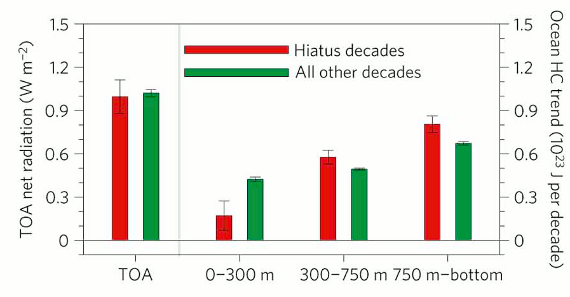
Although it is still within the range of model simulations, the rate of global surface air warming over the past decade has slowed. Climate scientists, being scientists, would like to explain exactly why that has happened.
There are several possible explanations. Perhaps it's due to the natural internal variability (short-term noise) in the climate system, with more heat being shifted to the deeper oceans as a result of more recent La Niña events. Perhaps it's due to a smaller global energy imbalance due to more aerosol cooling and lower solar activity offsetting more of the greenhouse gas-caused warming. Perhaps it's a combination of several factors, but which is the main cause of the slowed surface warming over the past decade?
Meehl et al. (2011) found that in their model simulations, there were 'hiatus decades' with little surface warming, but increased deep ocean warming (Figure 1). Similarly, Guemas et al. (2013) concluded that most of the recent slowed surface warming can be attributed to the increased accumulation of heat in the oceans.

Figure 1: Composite global linear trends for hiatus decades (red bars) and other decades (green bars). Positive values for top of the atmosphere (TOA) net radiation (left-hand side) indicate energy accumulating in the system (i.e. global warming). Right-hand side shows ocean heat content decadal trends, for the various ocean layers. From Meehl et al. (2011).
These results are also consistent with several studies showing a recent increase in ocean warming (e.g. Levitus et al. 2012, Nuccitelli et al. 2012, and Balmaseda et al. 2013).
Is this the best explanation for the slowed surface warming, and why is it happening? In a new study published in Geophysical Research Letters, Watanabe et al. (2013) seek to answer these questions.
Watanabe ran simulations with five general circulation models (GCMs) – CanCM4, CNRM-CM5, CSIRO Mk-3.6, HadCM3, and MIROC5. In comparing the observed temperature changes to the model simulations, they suggest that the recent surface warming slowdown is due to a large natural flucuation, and/or that some source of bias in climate models is making it difficult for them to simulate it.
They mainly focused their analysis on the MIROC5 climate model, and found that in 11 individual model runs, it did reproduce a surface temperature cooling trend over the past decade twice (Figure 2).
Figure 2: Global average surface temperature (SATg) trends during the last two decades for 1991–2000 (left), 2001–2010 (middle) and 2003–2012 (right). Thick ‘X’ marks indicate the observational linear trends, while thin marks represent the trends in historical ensembles from the five CMIP5 models having more than 10 members. Thick (thin) bars denote the 50% (75%) range of the trend values in each ensemble.
Watanabe et al. noted that the global energy imbalance from 2001 to 2010 in their climate models was somewhat smaller than in the observational data. Yet the climate models also simulate more surface warming than is observed. In other words, the slowed surface warming isn't a result of a smaller global energy imbalance due to factors like increased cooling from human aerosol emissions. As Watanabe et al. note,
"This implies that errors in the external forcing agents, even if they exist, do not explain the overestimation of the SATg trend for 2001–2010."
Similar to the Meehl et al. (2011) 'hiatus period', Watanabe et al. found a strong correlation between global surface temperatures and sea surface temperatures over the Pacific. They then applied a simple statistical correction using this relationship with sea surface temperatures to determine whether internal variability could explain the slowed global surface warming.
The model originally overestimated ocean heat content in the upper 300 meters and underestimated it for 300–1,500 meters for the decade of 2001–2010. When applying this statistical correction, Watanabe et al. found an enhanced overall ocean heat uptake, which suggests that the slowed surface warming can be explained by internal variability transferring more heat to the deep oceans, consistent with previous research.
Climate model simulations expect a long-term decrease in ocean heat uptake efficiency as a consequence of global warming. Watanabe et al. offer a possible explanation for this model expectation:
"Since climate will be far from equilibrium during this period, the weakening in κ [ocean heat uptake efficiency] should not be interpreted as saturation of heat uptake. Rather, it is likely that surface warming gradually stabilizes ocean stratification, thus reducing deep-water production at high latitudes, which acts to weaken advective heat uptake by meridional overturning circulation [cf. Meehl et al., 2011; 2013]."
So why has ocean heat uptake become more efficient over the past decade instead? We don't yet know the answer to that question. Watanabe et al. suggest it could just be a product of short-term natural variability in the climate system, or it could somehow be related to human influences.
"We cannot yet conclude whether the observed hiatus was part of unpredictable natural phenomena or a deterministic response to predictable changes in external forcing agents."
However, we expect ocean heat uptake efficiency to decrease in a warming world, so unless we're missing something, surface warming may soon return with a vengeance. Consistent with comments made by Virginie Guemas and Kevin Trenberth, Watanabe et al. conclude,
"Therefore, unless models miss effects of other forcing agents, it is likely that this [less efficient ocean heat uptake] process will occur and act to accelerate surface warming in coming decades."
This research adds another piece to the increasingly clear climate puzzle. The slowed surface warming over the past decade seems to be a result of more heat accumulation in the oceans due to short-term increase in ocean heat uptake efficiency. However, this trend seems unlikely to continue, and we will probably see accelerated surface warming in the coming decades.
Posted by dana1981 on Monday, 13 May, 2013
 |
The Skeptical Science website by Skeptical Science is licensed under a Creative Commons Attribution 3.0 Unported License. |